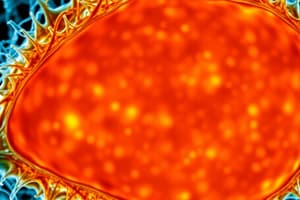Podcast
Questions and Answers
What is the primary purpose of magnification in microscopy?
What is the primary purpose of magnification in microscopy?
- To increase the brightness of the image
- To improve focus on the specimen
- To enhance color accuracy
- To enlarge an image (correct)
Which type of microscope allows for extremely high magnifications up to 1,000,000x?
Which type of microscope allows for extremely high magnifications up to 1,000,000x?
- Dissecting Microscope
- Light Microscope
- Optical Microscope
- Electron Microscope (correct)
What does resolution in microscopy refer to?
What does resolution in microscopy refer to?
- The capacity to see through the specimen
- The clarity of the image produced (correct)
- The ability to increase the brightness of the specimen
- The total magnification of the microscope
Which step is NOT part of standard microscope use?
Which step is NOT part of standard microscope use?
How does increasing magnification affect resolution?
How does increasing magnification affect resolution?
Flashcards
Magnification
Magnification
The ability of a microscope to enlarge an image.
Resolution
Resolution
The ability of a microscope to distinguish between two points that are very close together.
Light Microscope
Light Microscope
A type of microscope that uses light to illuminate the specimen.
Electron Microscope
Electron Microscope
Signup and view all the flashcards
Dissecting Microscope
Dissecting Microscope
Signup and view all the flashcards
Study Notes
Microscopy
- Microscopes are devices with magnifying lenses, used to view detailed, enlarged images of small objects.
- Two main functions:
- Magnification: Enlarges the image, akin to zooming in on a specimen.
- Resolution: The level of detail visible, determining the ability to distinguish two points as separate. Resolution increases with magnification.
- Types of microscopes:
- Light microscopes
- Electron microscopes
- Dissecting microscopes
- Electron microscopes provide extremely high magnification, up to 1,000,000x, allowing observation of incredibly small details within cells (sometimes down to molecular level).
- Typical parts of a light microscope include:
- Eyepiece lens (ocular lens)
- Body tube
- Revolving nosepiece
- Objective lenses
- Stage
- Stage clips
- Diaphragm
- Light source
- Coarse adjustment knob
- Fine adjustment knob
- Arm
- Base
Using a Microscope
- Place slide on stage and secure with stage clips.
- Adjust nosepiece to the lowest power objective lens.
- Look through the eyepiece.
- Use coarse focus knob to bring the specimen into view.
- Use fine focus knob for precise focusing.
Studying That Suits You
Use AI to generate personalized quizzes and flashcards to suit your learning preferences.




